15 to 19 February
Time for a longer survey: five days. What was interesting, was the forecast for strong winds blowing from the east and southeast during this survey. Hence, we were of course on the lookout for some oceanic birds. Eventually, we got only easterly winds, not south-easterly, but did get the oceanic birds.
I started seawatching on
15 February a bit later than usually after arriving with a weekday ferry, at 12h00, until 17h30. A White’s Thrush along the way to the seawatch point was a nice one, although not a seabird ;-). The weather was cloudy, but turned sunny rather soon, and the sea became a glistering mirror (read: bad lighting conditions). Luckily, there weren’t that many birds. Winds were blowing from the northeast with force 3 to 4, and there was some fog, which was lifted during the day when it turned sunny.
Seabirds:
1 Ancient Murrelet
Gulls:
23 Heuglin’s Gulls
1 Black-headed Gull
Swift(lets), swallows and martins:
2 Barn Swallows
Checklist on eBird:
https://ebird.org/checklist/S102674427
Count on Trektellen:
https://trektellen.nl/count/view/3323/20220215
16 February was a day with strong winds – force 6 – from the east, which in theory could be good for seabirds. It was, but not with high numbers. I started at 07h00 and seawatched until 17h00. At least it was cloudy, but visibility was limited due to fog. Things would only get better from this day on. Very noteworthy was the absence of any gulls, but a good count of Ancient Murrelets.
Seabirds:
8 Ancient Murrelets
2 jaegers spec.
2 Pomarine Jaegers
1 Long-tailed Jaeger
1 Red-necked Phalarope
Swift(lets), swallows and martins:
3 Barn Swallows
Checklist on eBird:
https://ebird.org/checklist/S102726959
Count on Trektellen:
https://trektellen.nl/count/view/3323/20220216
Winds continued to blow from the east, with force 6, on
17 February. Still cloudy, with some rain, and limited visibility. It was clearly a rough sea, good for seabirds, apparently. I watched from 07h00 until 17h15.
Seabirds:
33 Streaked Shearwaters
1 jaeger spec.
1 Pomarine Jaeger
1 Long-tailed Jaeger
4 Red-necked Phalarope
Gulls:
6 Black-tailed Gulls
Raptors:
1 Peregrine Falcon
Swift(lets), swallows and martins:
2 Barn Swallows
Checklist on eBird:
https://ebird.org/checklist/S103144787
Count on Trektellen:
https://trektellen.nl/count/view/3323/20220217
The fourth day,
18 February, turned out to be very good. Still the same winds and cloud-cover, but better visibility and dry. Again, I watched from 07h00 until 17h15.
Seabirds:
204 Streaked Shearwaters
3 Ancient Murrelets
2 jaegers spec.
23 Pomarine Jaegers
Ducks:
3 Eurasian Teals
Gulls:
5 gulls spec.
33 Heuglin’s Gulls
1 Black-tailed Gulls
Waders:
1 Common Redshank
1 Pacific Golden Plover
Swift(lets), swallows and martins:
8 Barn Swallows
Checklist on eBird:
https://ebird.org/checklist/S103145009
Count on Trektellen:
https://trektellen.nl/count/view/3323/20220218
The last day of this survey,
19 February, was good as well, although winds turned to north-northeast and dropped to force 5, at most. Visibility was good, especially when dry, but it did rain quite a bit. It turned noticeably cold. I started at 07h00, but finished at 12h30. Several other seawatchers were still present when I left and their results are included below.
Seabirds:
139 Streaked Shearwaters
2 Ancient Murrelets
1 jaeger spec.
1 Pomarine Jaeger
Egrets and herons:
2 white egrets spec.
Gulls:
128 Black-tailed Gulls
7 Heuglin’s Gulls
1 Mongolian Gull
Swift(lets), swallows and martins:
8 Barn Swallows
Checklist on eBird:
https://ebird.org/checklist/S103158625
Count on Trektellen:
https://trektellen.nl/count/view/3323/20220219 These are the counts of both others and me.
Remarks
On the one hand, we’ve seen good seabirds (and good numbers) before, without strong winds from the east, and on the other hand – and pointed out by Geoff before – easterly winds do often produce good results. I think we can say this was indeed the case during this survey. I believe it does not exclusively depends on wind direction and strength, but also on the time of the year and on the weather system over a much larger area, not just off Po Toi. It’s the right combination of several factors that might increase the chance for seeing many seabirds in Hong Kong. But of conditions are right, it’s awesome.
Furthermore, and weather related, the appearance of a pretty robust cold front on 19 February did seem to have a very clear impact on some birds. Remember that we failed to see such a clear pattern in November and December. But on 19th, with temperatures dropping to 11°C, all gulls were returning and flying to the west. Even Ancient Murrelets were seen flying in that direction.
Regarding the jaegers, the number we encountered – 35 in total – is pretty decent. Usually, Pomarine Jaeger is the earliest jaeger in late winter/spring, and we counted 27, with 23 on one day, which is rather high. Thank the easterly winds for that. Much more ‘unusual’ were the two Long-tailed Jaegers. The first one being an older individual, but not an adult in full breeding plumage, and the second one a very close-by 2nd calendar year bird. Both stood out very clearly from the Pomarine Jaegers seen on the same days and they were also surely not Parasitic Jaegers. The earliest day for the latter is 21 March, but there were a few that I could not identify as certain Pomarine or Parasitic, hence ‘jaeger spec.’. The previous early date for Long-tailed Jaeger was 12 March.
Again some interesting remarks about Black-tailed Gulls. Namely on 18th, with many shearwaters and jaegers, I recorded only one individual. But Roman Lo, who was seawatching from Cape D’Aquilar, counted 81. It seems that they fly closer to land to avoid strong headwinds that appear in the Lema Channel. But above all, we obviously don’t record every coastal migrant from Po Toi!
Again, good numbers of Ancient Murrelets, with a nice count of 8 on 16th. I made this video:
https://youtu.be/u5WUMBx8An0. Please do change the quality manually to 2160p 4K.
Of course, the most prominent seabird encountered, was Streaked Shearwater. It started with just 3 in the morning of 17th and the highest counts were 204 on the morning of 18th and 158 during just 50 minutes in the afternoon on the same day. The shearwaters were counted flying to the northeast, but later many flew to the west, and back. Some stayed around for a long time, some rested on the sea. Especially on 18th they were everywhere. We’ll never know the exact number, but it’s by far the highest count for Hong Kong and also the first record in February and during winter.
As many already know, this is only part of the story… I’m leaving it for the end of these remarks, as it is a bit of an additional story, but one that I think is useful to share.
In brackets I put the number of mistakes and errors I made and will discuss them later in the text.
On 17th, I saw 1 shearwater flying to the west. Actually two, and followed by a third one. My first idea was early Streaked Shearwater, evidently. But when I looked at the birds’ head, I noticed it was not whitish. I should say face, rather than head, as Streaked is darker towards its neck. The birds appeared small-headed, with a noticeably dark cap. The tail was rather long. The photo below was taken on another day, but perfectly illustrates this brief description (more photos are on eBird and a video is posted here:
https://youtu.be/u5WUMBx8An0; please do change the quality manually to 2160p 4K).


“These must be pale morph Wedge-tailed Shearwaters!”, I thought (1). A rare vagrant to Hong Kong, with only two previous records of dark morph singles in autumn. 20 minutes later, I encountered – presumably the same – three shearwaters flying northeast. Then one slowed down, turned a bit and showed a long, clearly wedge-shaped tail. I also noted a scaly appearance on the mantle and scapulars and an indistinctive pale diagonal bar on the upperwings. But with that wedge-shaped tail, these must indeed be Wedge-tailed Shearwaters! (2) I immediately shared the news with the birding community (3).
That afternoon, 33 shearwaters flew west again. And again I thought I must be looking at Wedge-tailed. There was nothing else on my mind.
The next day, they appeared even before I started the count. And that resulted in an unbelievable high number of 204 (4).
It attracted quite a few birders on Saturday and most of them saw the shearwaters (5).
Finally, when I did examine the 800+ photos at home, I realized very quickly that they were all Streaked Shearwaters. I immediately shared this conclusion with the birding community. I’m glad I at least recognized my own mistake.
Mistakes and errors:
(1) With Wedge-tailed, I was dealing with a vagrant seabird, but A/ did not went over all the characters I should be seeing and B/ did not check my photos clearly, or better yet, simply waited until the evening to check on my laptop and sort it out thoroughly.
(2) After the first thought, I was completely biased towards Wedge-tailed an was only looking at anything that matched that species, without considering anything else any longer. This is actually odd, as I usually challenge myself not only to confirm an ID, but also to look for anything that could prove my first idea wrong. E.g., when seeing a dark-rumped storm petrel off Po Toi, the first thought is Swinhoe’s, but then you should be looking not only why it’s this species, but also why it is not a Matsudaira’s. Same with the Bulwer’s Petrels I saw: clearly Bulwer’s, but in the field, I went over almost everything else, from noddies, jaegers, dark morph Wedge-tailed Shearwaters, dark storm petrels to even nightjars, but failed to see any characters that would point to any of these species, but Bulwer’s.
I obviously should have followed the same procedure here, and not just having only Wedge-tailed in my mind.
It's partly maybe also a matter of ego. I think everyone has that to some extent. You don’t want to report “shearwaters spec.” which you will identify when you’re at home. You want to identify them without any doubt on the spot, although there is actually nothing wrong with having a much more prudent approach. After all, it’s better to be approximately right than exactly wrong…
(3) Sharing the observation of a rarity with the birding community is in itself normal and correct, but you do make a statement. You do pound in what you’ve just pounded out and it leaves actually even less room to go back and think it over. I did not copy any of the photos to my laptop to look at them clearly that evening, I just thought I could do that at home, later, and show everybody good shots of Wedge-tailed Shearwater.
It’s strange. I’ve been trying to improve the seawatching in all possible ways: looking and finding new watch points to better cope with the wind, staying full days seawatching, replace pen and paper with a voice recorder, trying different cameras with different lenses or with digiscoping to improve photographic recording, bringing a laptop to work on the survey results,… But just copying the photos to examine them was something I completely neglected. I sure will be doing this in the future!
(4) Friends called it “crazy”, “unreal”, “unbelievable” and “ridiculous”. All very well meant, of course, but they were right. I should have gone through the ID process again; 200 Wedge-tailed Shearwaters is unreal for Hong Kong. “Sure they weren’t Streaked?” That thought never appeared to me. I was submerged in the believe that they were Wedge-tailed. The more you repeat that thought and the more you mention it to others, the less likely you’re going to change your mind. Even when I noted in the field that, flying head-on, they all seem to have whitish faces. “So what, they’re Wedgies and nothing else”, I must have been thinking.
(5) As far as I know, nobody doubted the ID of the birds (although some might quietly have wondered if there were Wedge-tailed for sure). We all are subject to confirmation bias and when we’re twitching species XYZ, that’s what we will be looking for. I felt rather honoured that people trusted my identification process and also did not doubt it, but confirmed it. But seeing Streaked Shearwaters on the photos, feelings turned into shame and embarrassment. All these people came over for the wrong reason.
Identification points:
The separation of pale morph Wedge-tailed Shearwater and Streaked Shearwater is not always that easy. And certainly in Hong Kong, we should be very careful with it. We now know that it is indeed a rarity and a single one or at most a few is what we can expect, not hundreds. And maybe only dark morphs and only in summer-autumn.
Shun, from Japan (Twitter: @morgan930_m), was so kind to let me share some of his photos of both species side-by-side.

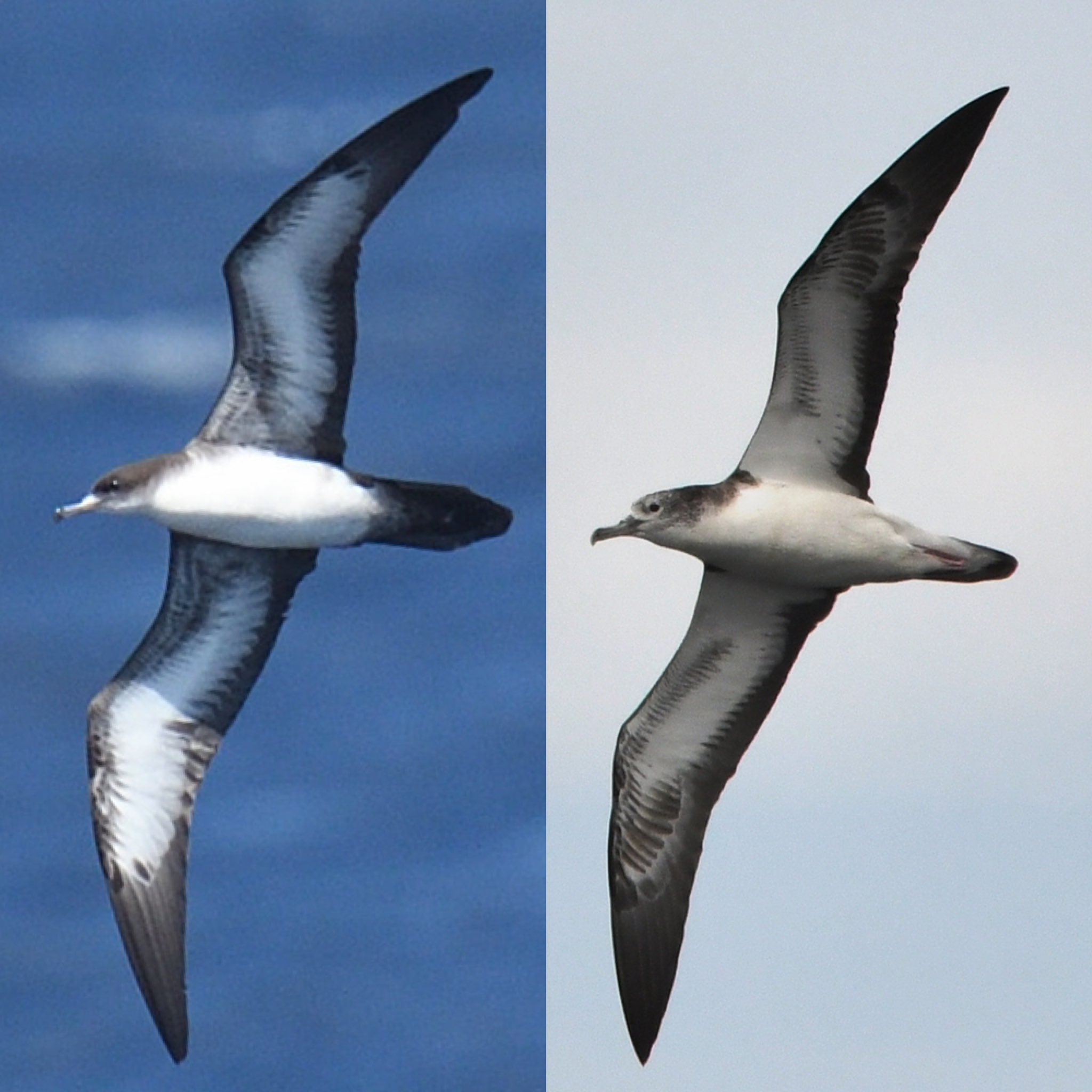

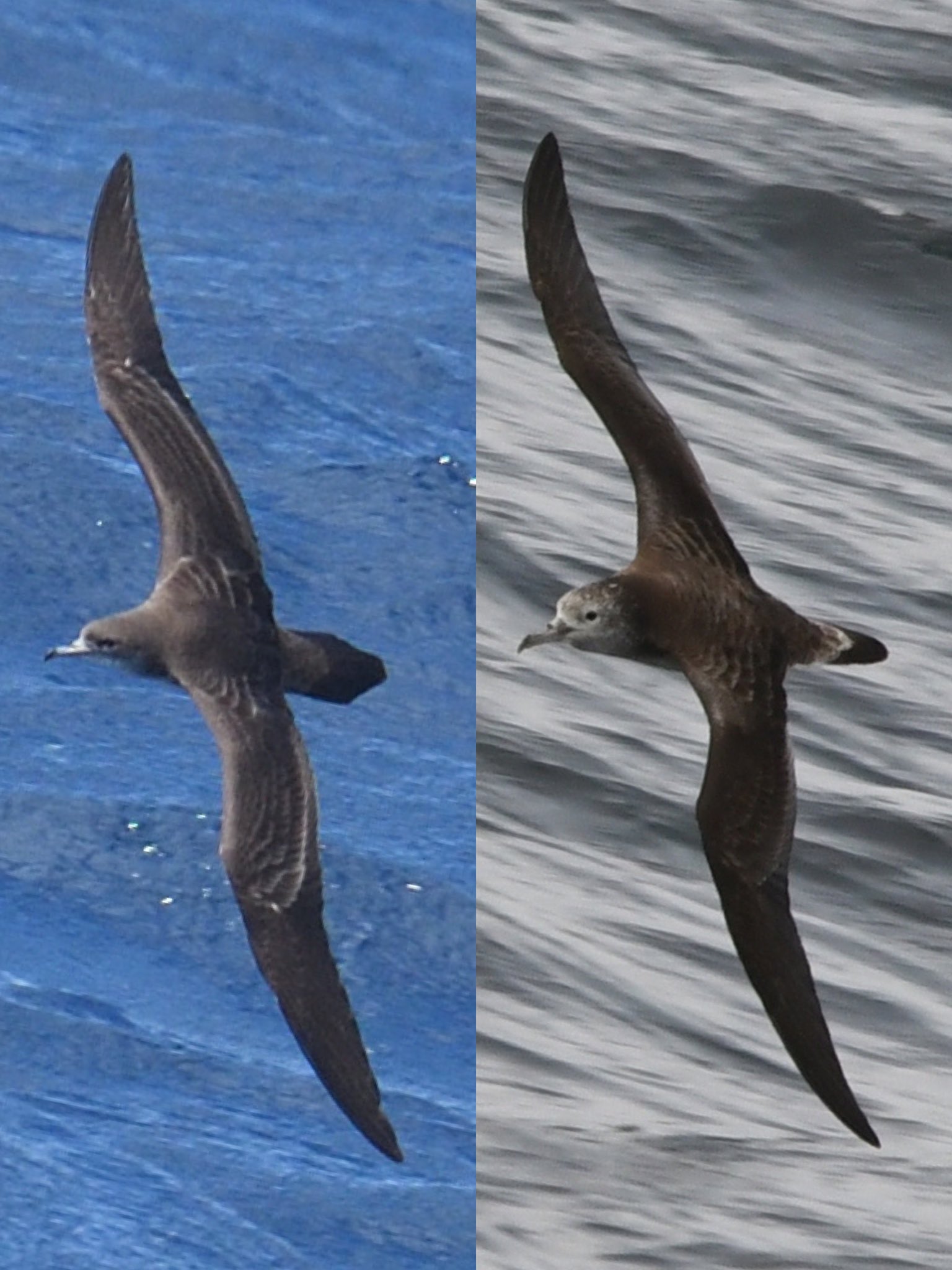

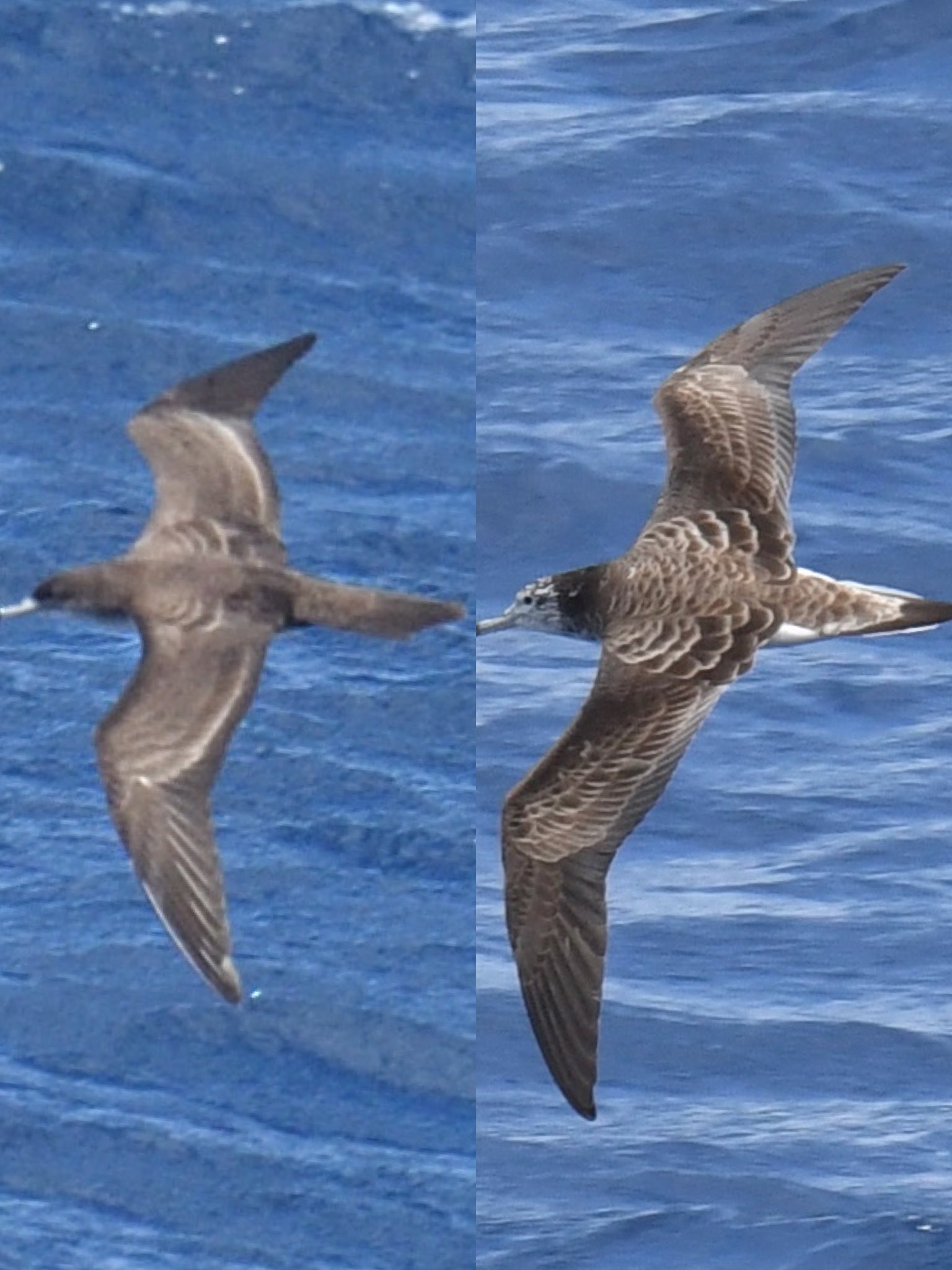

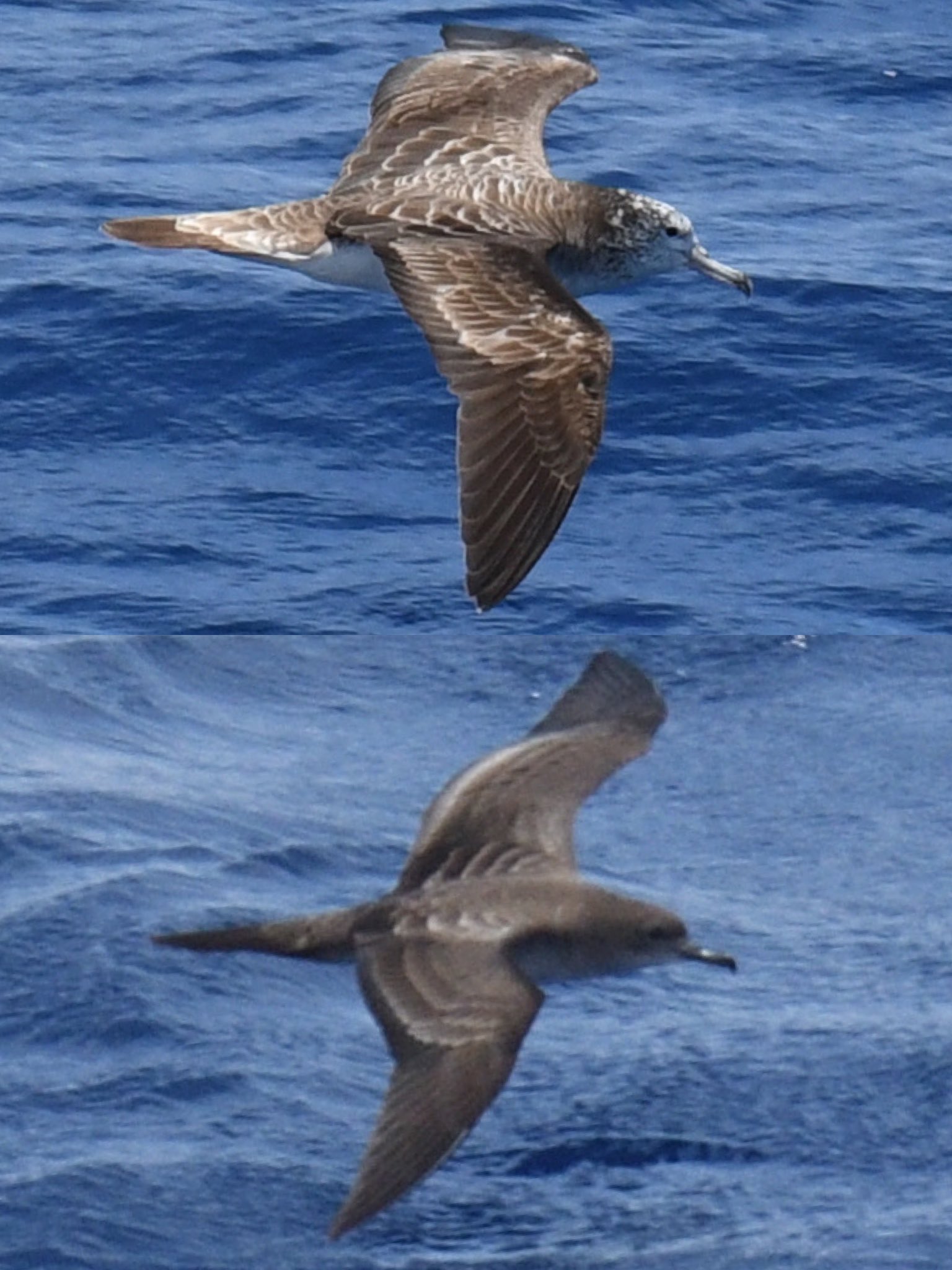

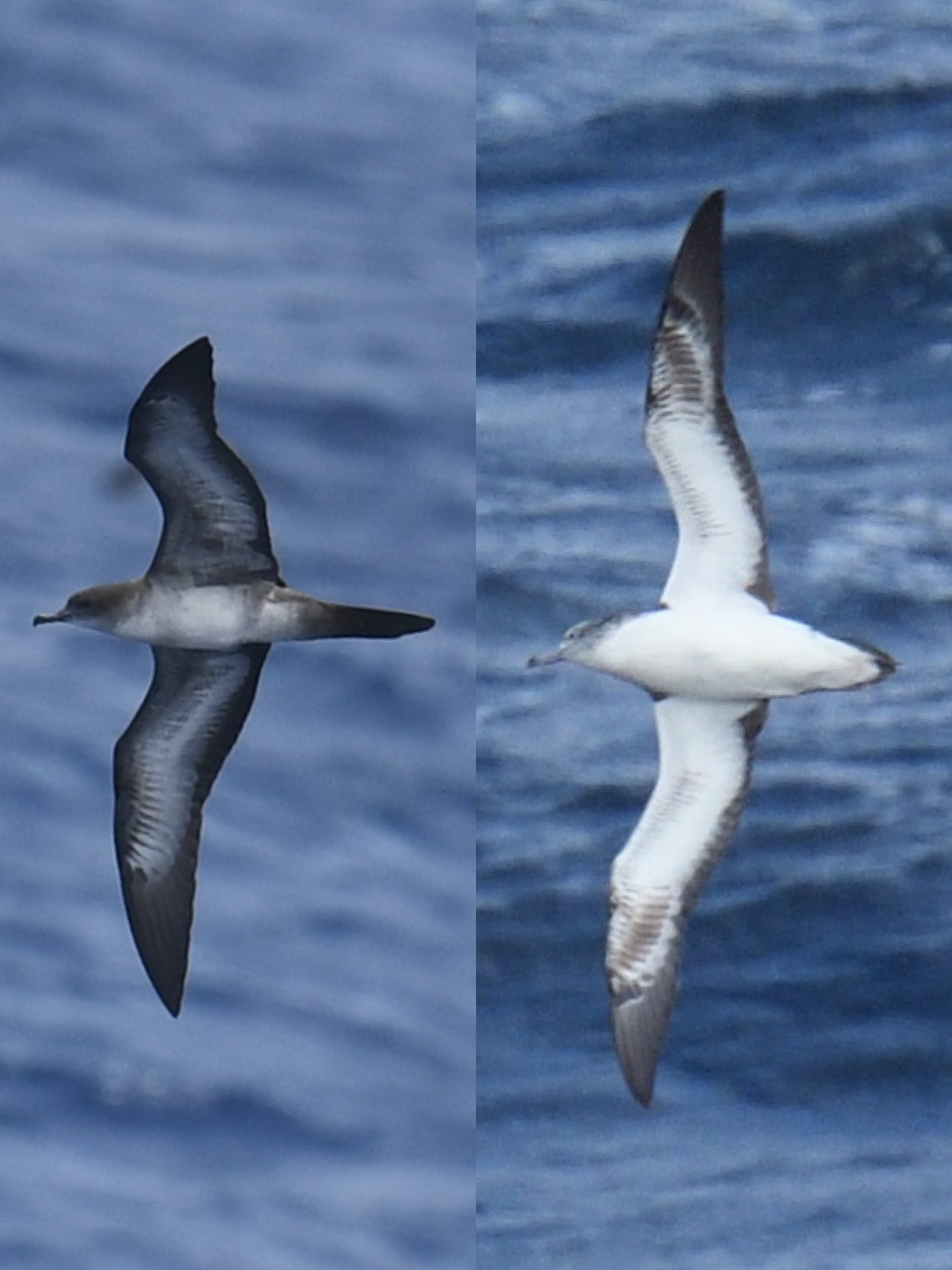
He also mentioned his video's of both species:
https://youtu.be/edfpmbwpGcI and
https://youtu.be/plqNtREmhzA. Thank you Shun!
Jemi Holmes reminded us of this website from the well-known seabirders Hiroyuki and Shoko Tanoi, also from Japan, with good photos of Wedge-tailed Shearwaters and this species side-by-side with Streaked on fig. 21 and fig. 22:
http://seabirding-japan.com/wedge-tailed-shearwater/
At a distance, when seawatching from land, even when the birds are relatively close (500-750m), many obvious differences start to fade away. But I do believe that the rear-end has some good clues. Wedge-tailed has a fairly clearly and dark undertail, while dark is rather limited to the tip of the tail in Streaked. And Wedge-tailed lacks any white on the uppertail and rump, whereas Streaked shows more or less white feathers. Tail shape and scaling on the upperparts are actually quite similar. And details on the head are not that clear from a distance.
Yann Muzika also stressed the difficulty of separating pale morph Wedge-tailed from Streaked “at a distance and without direct comparison, as flight style and structure are very similar”. He further added, based on his experience, that Wedge-tailed is quite variable in size and that larger birds are only slightly smaller than Streaked, making ID based on size very tricky. Unless given good views at close range, the pattern of the head and the undertail coverts can easily lead to mistakes. I can confirm that, yes ;-).
Congratulations if you’ve read until the end! Hope you enjoyed this story and it is at least something we can learn from. I sure did, obviously never too old to learn.
[
Last edited by badesc at 22/02/2022 06:48 ]


